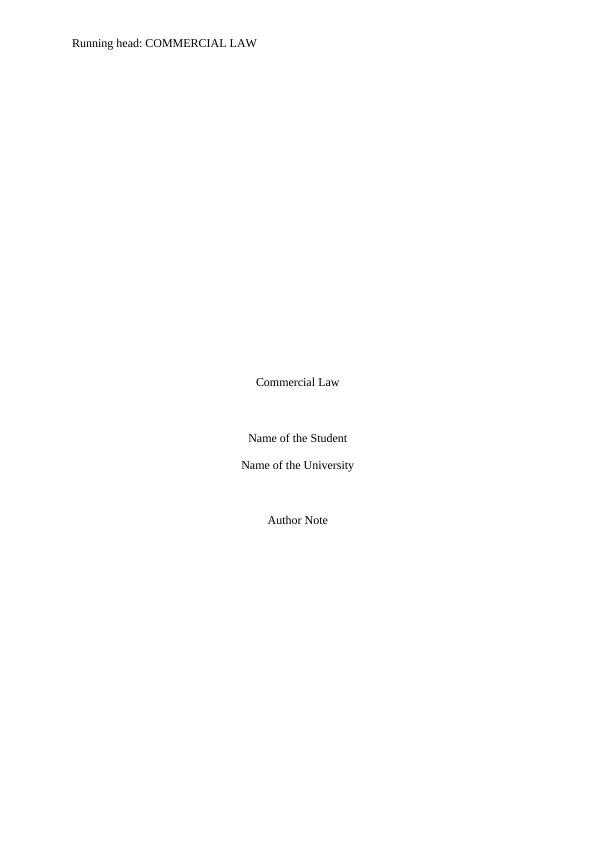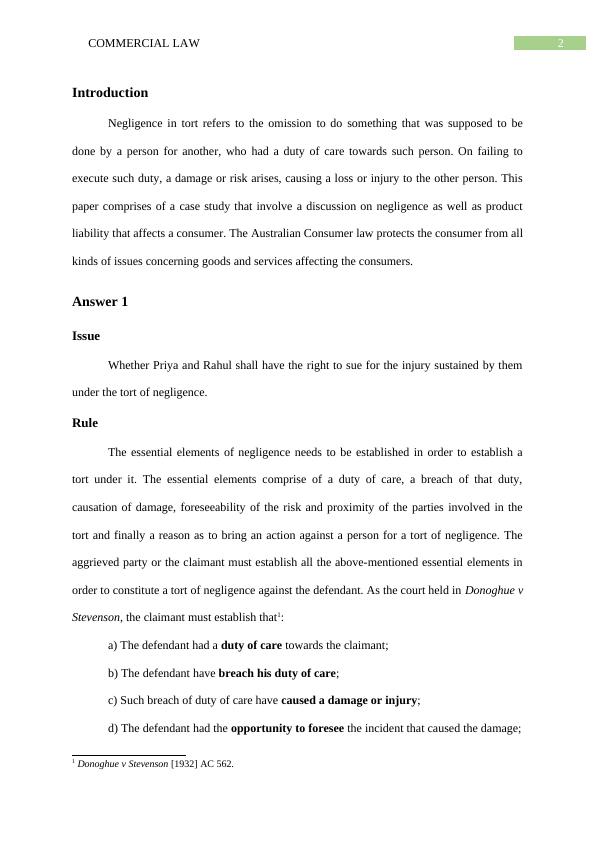Negligence and Product Liability under Australian Consumer Law
Added on 2022-11-14
12 Pages2991 Words438 Views
Running head: COMMERCIAL LAW
Commercial Law
Name of the Student
Name of the University
Author Note
Commercial Law
Name of the Student
Name of the University
Author Note

1COMMERCIAL LAW
Table of Contents
Introduction....................................................................................................................2
Answer 1........................................................................................................................2
Issue............................................................................................................................2
Rule............................................................................................................................2
Application.................................................................................................................4
Conclusion..................................................................................................................5
Answer 2........................................................................................................................6
Issue............................................................................................................................6
Rule............................................................................................................................6
Application.................................................................................................................8
Conclusion..................................................................................................................9
An overall conclusion..................................................................................................10
Bibliography.................................................................................................................11
Table of Contents
Introduction....................................................................................................................2
Answer 1........................................................................................................................2
Issue............................................................................................................................2
Rule............................................................................................................................2
Application.................................................................................................................4
Conclusion..................................................................................................................5
Answer 2........................................................................................................................6
Issue............................................................................................................................6
Rule............................................................................................................................6
Application.................................................................................................................8
Conclusion..................................................................................................................9
An overall conclusion..................................................................................................10
Bibliography.................................................................................................................11

2COMMERCIAL LAW
Introduction
Negligence in tort refers to the omission to do something that was supposed to be
done by a person for another, who had a duty of care towards such person. On failing to
execute such duty, a damage or risk arises, causing a loss or injury to the other person. This
paper comprises of a case study that involve a discussion on negligence as well as product
liability that affects a consumer. The Australian Consumer law protects the consumer from all
kinds of issues concerning goods and services affecting the consumers.
Answer 1
Issue
Whether Priya and Rahul shall have the right to sue for the injury sustained by them
under the tort of negligence.
Rule
The essential elements of negligence needs to be established in order to establish a
tort under it. The essential elements comprise of a duty of care, a breach of that duty,
causation of damage, foreseeability of the risk and proximity of the parties involved in the
tort and finally a reason as to bring an action against a person for a tort of negligence. The
aggrieved party or the claimant must establish all the above-mentioned essential elements in
order to constitute a tort of negligence against the defendant. As the court held in Donoghue v
Stevenson, the claimant must establish that1:
a) The defendant had a duty of care towards the claimant;
b) The defendant have breach his duty of care;
c) Such breach of duty of care have caused a damage or injury;
d) The defendant had the opportunity to foresee the incident that caused the damage;
1 Donoghue v Stevenson [1932] AC 562.
Introduction
Negligence in tort refers to the omission to do something that was supposed to be
done by a person for another, who had a duty of care towards such person. On failing to
execute such duty, a damage or risk arises, causing a loss or injury to the other person. This
paper comprises of a case study that involve a discussion on negligence as well as product
liability that affects a consumer. The Australian Consumer law protects the consumer from all
kinds of issues concerning goods and services affecting the consumers.
Answer 1
Issue
Whether Priya and Rahul shall have the right to sue for the injury sustained by them
under the tort of negligence.
Rule
The essential elements of negligence needs to be established in order to establish a
tort under it. The essential elements comprise of a duty of care, a breach of that duty,
causation of damage, foreseeability of the risk and proximity of the parties involved in the
tort and finally a reason as to bring an action against a person for a tort of negligence. The
aggrieved party or the claimant must establish all the above-mentioned essential elements in
order to constitute a tort of negligence against the defendant. As the court held in Donoghue v
Stevenson, the claimant must establish that1:
a) The defendant had a duty of care towards the claimant;
b) The defendant have breach his duty of care;
c) Such breach of duty of care have caused a damage or injury;
d) The defendant had the opportunity to foresee the incident that caused the damage;
1 Donoghue v Stevenson [1932] AC 562.

3COMMERCIAL LAW
e) The claimant and the defendant were in such a proximate relation that the
defendant could be held liable for not carrying out his duty of care.
By establishing the above-mentioned elements, the claimant could prove that the injury or
loss sustained by him was due to the negligence shown by the defendant.
The element of duty of care and the proximity of the parties was discussed in the
case of Anns v Merton London Borough Council where a two-stage test was put forwarded by
the court in order to prove that the defendant was in such close proximity of the claimant that
it could have prevented the injury or damage sustained by the claimant2. The element of
proximity between the parties was discussed at length in order to establish the most important
element, which is the duty of care of the defendant. A duty of care refers to the responsibility
of a person towards another due to certain proximity in the relation that they share, due to
their individual position. The proximity of the parties also refers to the fact that the defendant
had the opportunity to foresee or predict the forthcoming risk or danger for his advantageous
position that caused the injury to the claimant, had the defendant not failed to carry out his
duty of care. In the case of Caparo Industries plc v Dickman, also known as the Caparo Test
discuss about the significance of the element of proximity along with two other factors in its
three-stage test3. The case lays down that the closeness or proximity of the defendant which
aids his actions in order to prevent the mishap that might cause a loss or injury to the claimant
when he fails to carry out his duty. It also states that the proximity of the defendant gives him
a vantage point to foresee the probable danger or risk that might affect the claimant. Such
foreseeability of the defendant holds him liable for not taking sufficient care to prevent the
breach of his duty of care.
The element of breach of duty of care by the defendant giving rise to the causation
of damage was discussed in the case of Hall v Brooklands Auto-Racing Club, where it was
2 Anns v Merton London Borough Council (1978) AC 728.
3 Caparo Industries plc v Dickman (1990) 2 AC 605.
e) The claimant and the defendant were in such a proximate relation that the
defendant could be held liable for not carrying out his duty of care.
By establishing the above-mentioned elements, the claimant could prove that the injury or
loss sustained by him was due to the negligence shown by the defendant.
The element of duty of care and the proximity of the parties was discussed in the
case of Anns v Merton London Borough Council where a two-stage test was put forwarded by
the court in order to prove that the defendant was in such close proximity of the claimant that
it could have prevented the injury or damage sustained by the claimant2. The element of
proximity between the parties was discussed at length in order to establish the most important
element, which is the duty of care of the defendant. A duty of care refers to the responsibility
of a person towards another due to certain proximity in the relation that they share, due to
their individual position. The proximity of the parties also refers to the fact that the defendant
had the opportunity to foresee or predict the forthcoming risk or danger for his advantageous
position that caused the injury to the claimant, had the defendant not failed to carry out his
duty of care. In the case of Caparo Industries plc v Dickman, also known as the Caparo Test
discuss about the significance of the element of proximity along with two other factors in its
three-stage test3. The case lays down that the closeness or proximity of the defendant which
aids his actions in order to prevent the mishap that might cause a loss or injury to the claimant
when he fails to carry out his duty. It also states that the proximity of the defendant gives him
a vantage point to foresee the probable danger or risk that might affect the claimant. Such
foreseeability of the defendant holds him liable for not taking sufficient care to prevent the
breach of his duty of care.
The element of breach of duty of care by the defendant giving rise to the causation
of damage was discussed in the case of Hall v Brooklands Auto-Racing Club, where it was
2 Anns v Merton London Borough Council (1978) AC 728.
3 Caparo Industries plc v Dickman (1990) 2 AC 605.

End of preview
Want to access all the pages? Upload your documents or become a member.
Related Documents
Commercial Law: Rights to Sue in Tort of Negligence and Australian Consumer Lawlg...
|11
|2902
|193
Tort Law: Establishing Negligence and Defense of Volenti Non Fit Injurialg...
|9
|2482
|62
Tort of Negligence and Product Liability in Australian Consumer Lawlg...
|11
|2690
|326
Business Lawlg...
|11
|2527
|238
Analysis of Negligence Liability in the Case of Cliff and Mary vs Susanlg...
|7
|2264
|195
Tort Law: Duty of Care and Negligencelg...
|9
|1989
|98